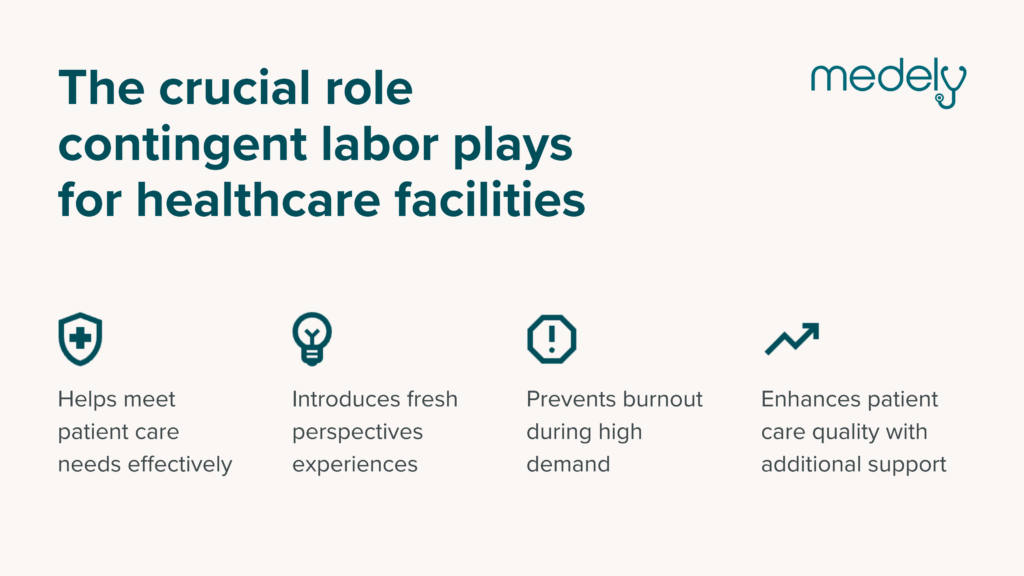What do you do when you have to manage not just one nursing staff team but two? How do you make the two function as one cohesive team?
Hospitals and other healthcare facilities are constantly challenged to maintain the right level of nursing staff for the constantly changing number of patients and the required level of care for each. One effective solution is contingency staffing. This option offers flexibility, reduced stress and strain on full-time staff, and increased control over budget management. However, if not managed properly, merging two groups, one from inside your organization and one from the outside, can be fraught with conflict and disruption.
Here, we explore challenges employers face and strategies that can ensure the successful management of your hybrid nursing team.
The Growing Demand for Nurses
Healthcare organizations are under pressure to grow their nursing staff. The U.S. population is aging, with the oldest Baby Boomers approaching 80. The demand for healthcare will only increase.
Employers are struggling to fill vacant positions. For instance, some are turning to existing employees and asking for overtime volunteers or offering crisis pay. Among participants in the 2024 NSI National Health Care Retention & RN Staffing Report, 26 percent were planning to expand their recruitment budget.
The nursing shortage plaguing healthcare facilities stems from multiple complex factors:
- Aging workforce: Many experienced nurses are reaching retirement age.
- Increasing demand: An aging population requires more healthcare services.
- Limited education capacity: Nursing schools struggle to expand enrollment due to faculty shortages and clinical placement limitations.
- High turnover: Stressful working conditions and burnout lead many nurses to leave.
- Uneven distribution: Some geographic areas face more severe shortages than others.
A Nursing Shortage
The nursing profession has been plagued with a nationwide staffing shortage for nearly a decade. Employers, possibly including your organization, face the challenge of maintaining appropriate shift coverage and ensuring the highest quality of patient care.
The 2024 NSI National Health Care Retention & RN Staffing Report states that hospital registered nurses have a turnover rate of 18.4 percent and a vacancy rate of 9.9 percent.
Staff shortages in healthcare impact patient care quality. Overworked nurses struggle to deliver their usual standard of thorough care, potentially leading to missed treatments, decreased patient satisfaction, and even critical errors. Moreover, when experienced nurses retire or resign, they take invaluable skills and knowledge, compromising the overall quality of care.
Flexibility
Imagine always having the staff you need daily and night, with the shift coverage to meet all patients’ needs. Perhaps you can overcome the shortage and hire enough employees to accomplish this. But it’s unlikely that you will have a consistent number of patients or each will require the same intensity of treatment and attention.
At any given time, you need the right number of staff — no less, no more — to provide optimal patient care while keeping staffing costs under control. You need flexibility.
Each employee hired costs your organization salary, benefits, bonuses, overtime pay, perks, training and development, and more. It’s an investment. When you have a temporary surge in patients or those requiring more focused care, adding to the permanent ranks may not be the best choice. Sometimes, a temporary situation requires a healthcare staffing solution.

The Contingency Nursing Staff
To address these staffing challenges, healthcare facilities must develop and implement comprehensive workforce solutions. A key component of an effective strategy is integrating contingency nurses alongside permanent staff, providing immediate relief and flexibility.
Contingency nurses play a crucial role in healthcare organizations by:
- Balancing patient care demands with staff needs and budget constraints.
- Introducing fresh perspectives and diverse experiences from other institutions.
- Supplementing permanent staff during high-demand periods to prevent burnout.
- Enhancing patient care quality by providing additional support.
Contingent nurses work side-by-side with your full-time employees, performing the same duties and helping ensure consistent, high-quality care. Full-time employees may have a better chance at work-life balance. Contingency nursing staff can also ease the pressure on your budget; they do not bring the costs associated with full-time employees.
A contingent staff added to your full-time staff can greatly benefit all parties. However, to reap those benefits, you must carefully manage the situation.
Healthcare Staffing Strategy
While contingent and permanent nurses need to work together seamlessly, the reality is that you are managing two separate groups in the same workplace. For your employees, your organization is their home territory. They know how things work and know what to expect.
Temporary nurses, however, are new to your organization. They will not start with the sense of belonging your employees have. They will need to develop that with your help.
It is well worth your while to develop a strategy for managing and meeting the needs of both groups.
Things to Consider When Developing Your Strategy
The American Hospital Association offers several issues to address when building your strategy, including:
- Partner with a staffing resource and develop a plan for contingency staffing that fits your budget and allows you to plan ahead.
- Determine how to get the most benefit from contingent staff, such as enhancing patient care and easing stress on permanent employees. Make sure employees understand how this benefits them as well as the organization.
- Make contingent staff feel included and welcome.
- Identify the strengths they bring to your table.
Determining What You Need
You have to balance several factors when developing your nursing staff, including the mix of staff’s skills and abilities, any processes that can be automated, costs, outcomes for patient care, and the needs of your nurses and your organization.
With these issues in mind, work through the four stages for staffing that the American Nursing Association identifies.
- Forecasting. Use current data and policies to plan for your future staffing needs proactively.
- Scheduling. Project your workload needs for the next two to three months, and set the number of staff needed.
- Staffing. Determine what’s needed for day-to-day operations for each shift.
- Improving. Assess staff’s activities and identify areas that need scheduling and forecasting edits.
Putting Strategy into Action
Your employees and contingent staff need to work together as a cohesive team. Contingent nurses need to feel the same sense of inclusion and belonging as full-time employees. Use your strategy to develop steps you can take to make sure this happens. For example:
- Provide Mentoring. As mentioned earlier, contingency staff will not know your organization or employees. They will need help acclimating to its specifics and feeling like they belong. Assigning an employee as a mentor can promote that feeling.
- Conduct Onboarding. Include an onboarding and orientation in your contingency staffing process. You can welcome staff and introduce company culture and policies. Provide a welcome package including job description, roles, expectations, and goals.
- Identify Strengths. Inventory contingency staff’s skills and strengths and use the results to optimize placement and assignments.
- Support Communication and Collaboration. The more the permanent and contingent staff work together to achieve common goals, the more they can develop a rapport and act as a team.
- Train as Needed. Contingent nurses come to you highly skilled and capable. However, each organization has its own systems, processes, and software. Provide training for anything unfamiliar to them.
- Recognize and Celebrate Achievements. Contingent and permanent nurses alike will appreciate it.
Partner with Medely
Medely provides fully vetted, credentialed, talented contingent staff to healthcare facilities. We aim to help you carry out your strategy and achieve your goals. We make it easy for you to request staff through our booking platform.
When managed well, permanent and contingent nursing staff can work as an effective team to ensure the best quality of patient care, reduce strain on permanent employees, help you manage your budget, and adjust to variations in patient volume and needs. Learn more at the link below.



